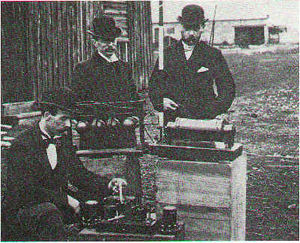During the years 1899-1902, war raged on the southern tip of the African continent. The conflict between Britain and the Afrikaners (Boers) of South Africa struck a major blow to Pax Britannica, resulting in the most devastating military losses for Britain since the Napoleonic Wars. The war is remembered for the refinement of several military tactics including guerrilla warfare by the Boers, the infamous civilian concentration camps established by the British-and the first use of wireless telegraphy by an army and navy on active service in a military operational area. The potential benefits of using wireless technology for military purposes was appreciated by both the Boers and the British, but the timing and manner in which this application evolved, and the final outcome, was very different for the two sides.
In February 1898, C. K. van Trotsenburg, general manager of telegraphs in the South African Republic, initiated confidential correspondence with Siemens Brothers in London to explore purchasing wireless telegraphic equipment. He had researched the new technology, and with tensions building with the British in South Africa, he sought a more secure communications network by in – stalling wireless links between the Boer military headquarters in Pretoria, five forts surrounding the city, and a further fort in Johannesburg. He traveled to Europe in June 1899 and visited companies manufacturing wireless equipment in London, Paris, and Berlin. As a result of his evaluations, he placed an order on 24 August 1899 through the Siemens agent in Johannesburg for three Siemens and Halske wireless stations. If satisfied with their performance, he planned to order three more. The equipment, however, never reached the Boers. War broke out in October and the British traced the customs paperwork. The equipment was confiscated in Cape Town, and some of the instruments were cannibalized by the British army for its own use.
In contrast, British army use of wireless during the war was prompted by Guglielmo Marconi. Always the entrepreneur, Marconi saw an opportunity to promote his wireless telegraph system and offered to send wireless equipment and company engineers with the British troops shipping out to South Africa. On 24 November1899, equipment for erecting five portable wireless stations and six Marconi engineers arrived in Cape Town. The equipment first provided ship-to-shore communications during troop disembarkation. Wireless equipment was successfully demonstrated on 4 December at Cape Town Castle in front of the military staff and invited dignitaries. In mid-December, the equipment was carried into the field by two separate units going to the relief of the besieged towns of Kimberly and Ladysmith. Over the next two months, however, events took an expected turn for the British as the wireless equipment was moved inland for the army’s use.
British army field trials of the Marconi equipment were soon considered a failure as communication between the portable field stations was irregular at best. The causes for the failure have since been variously attributed to equipment design, meteorological conditions, and poor grounding conductivity in the South African soil. Whatever the cause, finger-pointing started between the army and Marconi, and on 12 February 1900 the director of Army Telegraphs ordered the equipment dismantled and removed.
The army’s failure, however, became a Royal Navy success. By March 1900, the five Marconi wireless sets were installed on five cruisers in Delagoa Bay off the coast of Lourenco Marques (now Maputo, Mozambique). Wireless was used successfully for communications among the five ships, which were securing a blockade against supplies being landed and delivered to Boer forces in the Transvaal. In addition, by connecting a land telegraph line to one of the wireless-equipped ships anchored near shore, the remaining four Royal Navy cruisers were able to communicate with the distant navy headquarters in Simonstown, Cape Colony, while at sea up to 100 kilometers away.
The Royal Navy’s success in utilizing wireless in the Boer War theater greatly aided the rapid development and implementation of wireless throughout the navy. The British army did not pursue wireless as vigorously. As a result, by the advent of World War I, the Royal Navy was much more advanced in its use of wireless than the British army.
Sources Baker, Duncan. 2006. “Wireless Telegraphy in South Africa at the Turn of the Twentieth Century.” In History of Wireless, edited by Tapan Sarkar et al. New York: John Wiley. Baker, William. 1970. A History of the Marconi Company. London: Methuen. Beauchamp, Ken. 2001. History of Telegraphy. London: Institution of Electrical Engineers. Burns, Russell. 2004. Communications: An International History of the Formative Years. London: Institution of Electrical Engineers. Hezlet, Arthur. 1975. The Electron and Sea Power. London: P. Davies. Pakenham, Thomas. The Boer War. New York: Random House.
